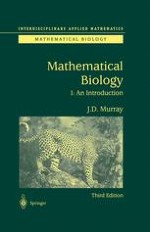2002 | OriginalPaper | Chapter
Reaction Diffusion, Chemotaxis, and Nonlocal Mechanisms
Author : J. D. Murray, FRS
Published in: Mathematical Biology
Publisher: Springer New York
Included in: Professional Book Archive
Activate our intelligent search to find suitable subject content or patents.
Select sections of text to find matching patents with Artificial Intelligence. powered by
Select sections of text to find additional relevant content using AI-assisted search. powered by
In an assemblage of particles, for example, cells, bacteria, chemicals, animals and so on, each particle usually moves around in a random way. The particles spread out as a result of this irregular individual particle’s motion. When this microscopic irregular movement results in some macroscopic or gross regular motion of the group we can think of it as a diffusion process. Of course there may be interaction between particles, for example, or the environment may give some bias in which case the gross movement is not simple diffusion. To get the macroscopic behaviour from a knowledge of the individual microscopic behaviour is much too hard so we derive a continuum model equation for the global behaviour in terms of a particle density or concentration. It is instructive to start with a random process which we look at probabilistically in an elementary way, and then derive a deterministic model.
